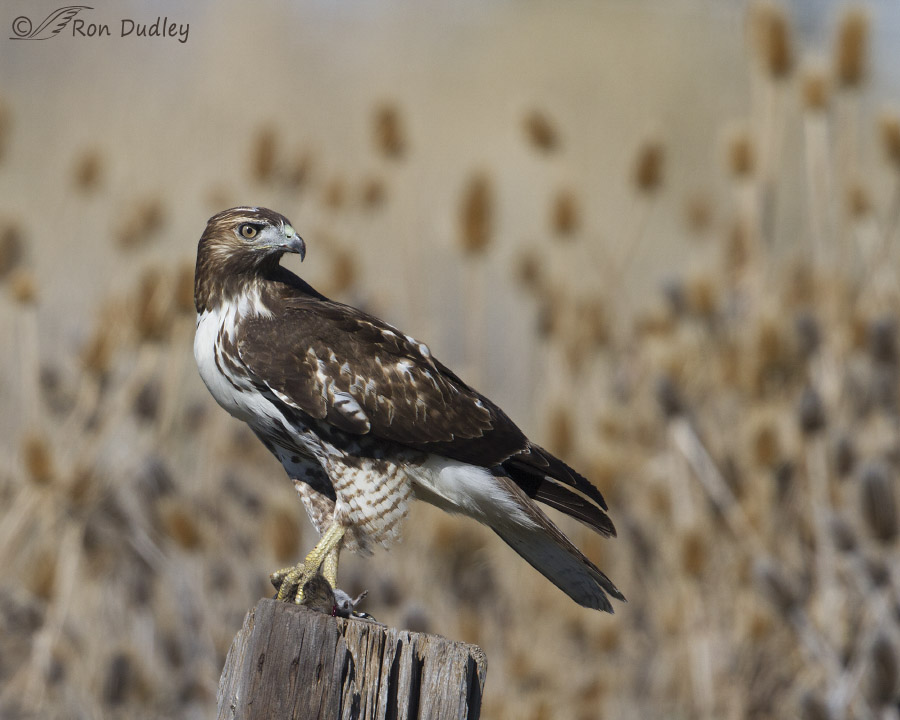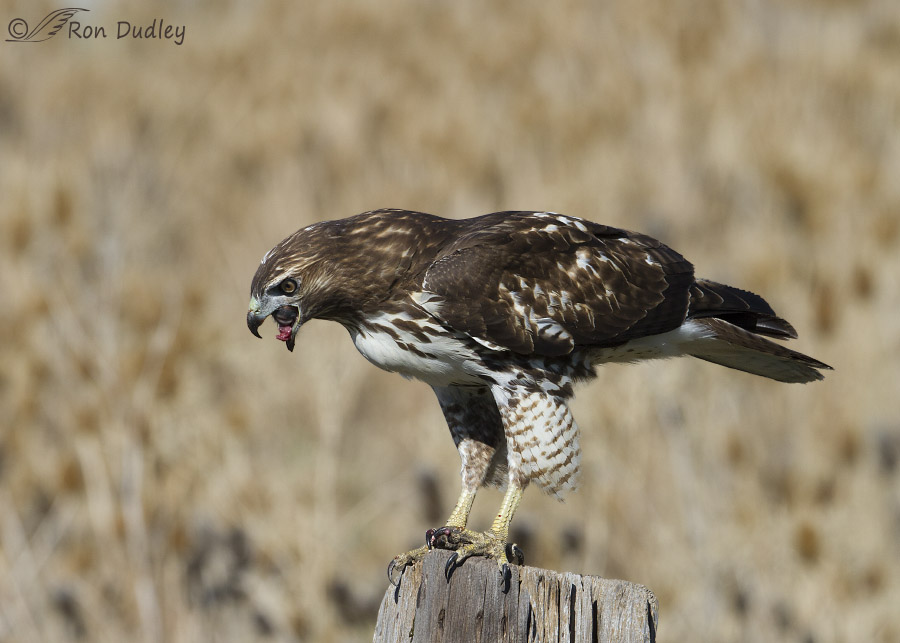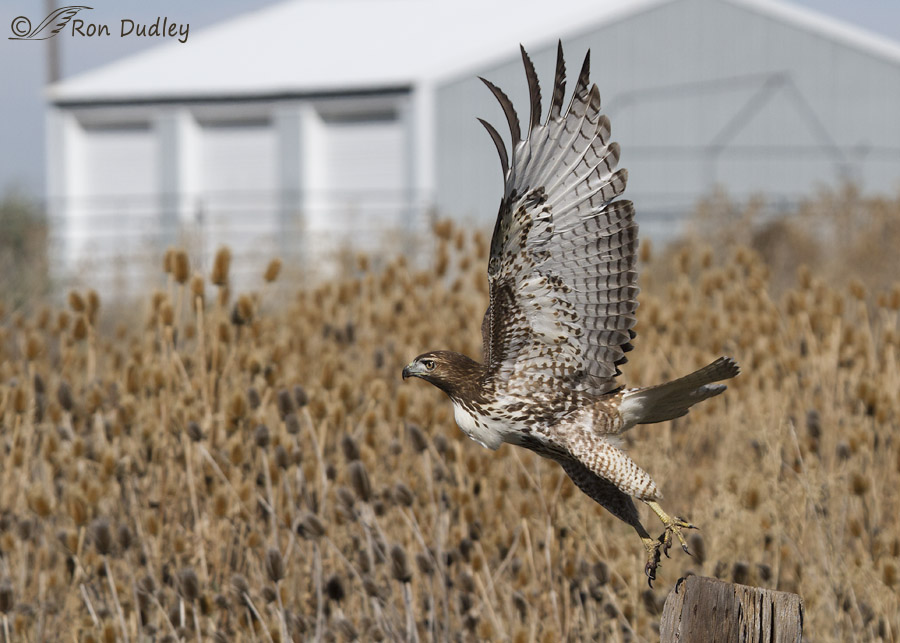When food is plentiful raptors take advantage of the situation. Tomorrow things might be different.

1/3200, f/6.3, ISO 500, Canon 7D, Canon EF500mm f/4L IS II USM +1.4 tc, not baited, set up or called in
I found this juvenile Red-tailed Hawk on a leaning post in Farmington this past September. The bird had just captured a vole and its obvious intent was to consume it on this perch but it was close to a road and the occasional passing vehicle made it just a little bit nervous. As you can see by the hawks posture it’s prepared for instant flight with its prize if necessary.
Notice the already bulging crop – this bird had been eating well recently and was still prepared to eat again. The post was on the edge of a pasture that was probably teeming with voles. The splotchy phragmites background likely won’t appeal to some but the hawk stands out well enough that it really doesn’t bother me.

1/2500, f/7.1, ISO 500, Canon 7D, Canon EF500mm f/4L IS II USM, not baited, set up or called in
The hawk made quick work of the vole and swallowed most of it in one gulp after first turning the rodent inside-out. I’ll spare you the gory details and photos.
These images reminded me of the sharpness I used to get with my 500mm lens before something apparently went out of whack. The lens is scheduled to arrive at the Canon Service Center on Tuesday and I’m hoping for a quick fix and return. In the meantime I’m going through serious withdrawal and posting images taken before the malfunction. I posted three images of this bird back in September but these two are new to my blog.
Ron
Addendum: As an afterthought I decided to include one more image to show you my major photographic frustration during the session with this hawk.

1/2500, f/7.1, ISO 500, Canon 7D, Canon 100-400 @ 220mm, not baited, set up or called in
The ugly building in the background simply could not be avoided when the hawk took off after its meal. Too bad, because I really like the take-off posture. And yes, that crop is really bulging now – to the point that the feather’s aren’t laying flat.


…..after turning the vole inside out…….This really got me thinking!
What a neat trick, preparing it’s food to be eaten.
I would be interested in the “gory details”.
An example of where hawks and humans are alike: food preparation!
There must be other examples .
This reminds me of a morning, sitting on the back steps, eating breakfast, enjoying the bird activity. The local outdoor cat came near me and sat, facing the same direction that I was facing. After a few minutes of this, I just laughed, realizing that we were both engaged in our favorite activity: bird watching.
Thanks for the photos…always amazing….and for being so interested in how nature works.
SUE
“I would be interested in the “gory details”.”
I’ll email you one of those “inside out” shots, Sue. It was a pretty nifty trick!
Beautiful shots. Since I usually concentrate on the bird, I didn’t notice the ugly building until I read your post. I was just aghast at that bulging crop!
Thank you, Tana. For me that building pulls my eye away from the bird. I really don’t like it.
magnificent!!
Thank you, Lois.
Ron, all three photos are beautiful of course, but particulary the take-off shot with the building. Context is another layer of the story, and the building (not ugly) does not distract one bit from a gorgeous photograph! I also appreciate the context of gory details…especially when a raptor is involved!
Susan, I thought about my use of the word “ugly” when I wrote it. Another case of being in context – the building isn’t ugly as buildings go but in the background of one of my photos that I like otherwise I sure as heck find it so! 🙂
How wonderful (and how practical) that a young bird is finding food and taking advantage of it. I found myself wondering whether wild animals can get ‘fat’ and had my questions answered. Thank you.
We all learn “stuff” here, don’t we, EC?
What a perfect photo. I have one tiny problem with the text, however. I have rarely if ever found you to be anthropomorphic, Ron, but your use of the word “gluttonous” bothers me. In common usage it implies a somewhat gross lack of control over one’s eating, a thoroughly human kind of ugly excess. As you also state, it is cheering to see them getting plenty to eat! I have a sensitive “button” when people apply human attributes to wild animals, trying to make them seem like us. (One we hear frequently and it drives me crazy is “it knows we are trying to help it”.) It contributes to a lack of understanding of their true, non-human natures. I know you also agree with this. Sorry to pontificate, but I feel that our only chance of truly help wildlife is to honor their unique behaviors and needs. No insult intended, I admire you immensely. Thank you for the photos!
Deborah, why would you say that gluttonism is exclusive to humans (“thoroughly human”)? Some animals simply overeat (the scientific name of the Wolverine is Gulo gulo – gulo means “glutton”). You might find the following article interesting:
http://www.nytimes.com/2012/06/10/opinion/sunday/our-animal-natures.html?pagewanted=all&_r=0
Two key excerpts from the article:
* “Do wild animals get medically obese? Do they overeat or binge eat? I learned that yes, they do.”
* “Mark Edwards, an animal nutrition expert, told me, “We’re all hard-wired to consume resources in excess of daily requirements. I can’t think of a species that doesn’t.” Wild animals can get fat with unfettered access to food”.
It’s my contention that applying the term “glutton” to animals isn’t being anthropomorphic. True, the word may have a negative connotation that does not apply here but I chose to go with it anyway.
Different strokes I guess…
I suppose what I am reacting to is not the fact of the word, but rather its judgmental connotations (which I realize are not what you are implying). Because of the area in which I work with animals – rehab – I see the results of much misunderstanding of concepts, leading to sometimes destructive behavior. For example, hawks are “mean” because of their expression. Therefore they are to be feared and often shot. etc. In our education programs we get many questions which reflect anthropomorphic projections. So, I tend to be very precise about describing behavior etc. What I was questioning about the word “glutton” in common usage was its sense of ugly overindulgence… as if hawks are “greedy” and “pigs”. I know that was not YOUR meaning, but people are very simplistic sometimes. You pass on marvelous observations and musings about birds – you teach so much through your own investigations. I do not mean to criticize… and, thank you for the link. It looks very interesting.
Fair enough, Deborah.
I used to be much more sensitive to “anthropomorphic statements” than I am today. But as time passes I’m realizing that there’s not as much separating other animals from us as I used to think there was. In fact I’m beginning to think of the word anthropomorphic almost as an anachronism…
And if we are to assume that human characteristics/traits/emotions and those of other animals are often exclusive to each other why don’t we also use the term “zoopomorphic” just as freely for the other side of the coin? (rhetorical question…)
What a piggy! Love that last shot but I see what you mean about the building.
I love seeing them get plenty to eat, Arwen. Too many do not, especially the juveniles.
Absolutely love these raptors and your images capture them spectacularly! I could spend hours watching their behaviors and activities!
Thank you, Fraida. So could I and sometimes I do…
Fantastic shots Ron! I’m sure you have withdrawal. Hope they get your 500 back soon.
Charlotte
Thanks, Charlotte. Me too.